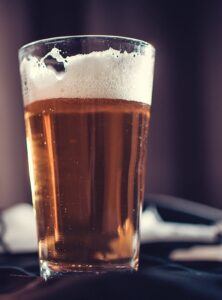I realize that there is a whole movement of people who love a cloudy hazy beer. The cloudier the better for those people… which is all well and great.
But not this guy! Nope I am more of a traditionalist when it comes to beer I guess… I like my beer to be clear… I want to

And I definitely cannot stand floaties in my home brew… I just don’t get how anyone does to be honest… cloudy is one thing… but floaties? I have purchased commercial beers that not only have floaties in the beer, but are proud of it and advertise that it is full of floaties… well each to his own and brew on!
So if you are like me… then this post is for you… because today I am going to show you how to clear home brew beer my friend… in fact I am going to share 7 proven methods with you!
If you are new to homebrewing you may wish to start with my How to Home Brew guide, in order to get the basics down.
7 Ways to Make Your Beer Clear
So what I have done with this post is I have listed and explained all 7 of the things I do to make clear home brew in the order that I do them… I have also given each method a Rating… the higher the rating the better it is at clearing beer.
Now some times I will not do all of the things listed and other times I will… it just depends on the mood I am in or what supplies I have on hand.
Even doing 1 or 2 of the things listed below is going to result in a much clearer beer then not doing anything…
And if you do all 7 items below you are going to have a very nice and clear brew on your hands…
So without further ado let’s take a look at the first method on the list…
Whirlfock
Whirl flock is basically compressed Irish moss.
Brewers have been using Irish moss for years to help clear their beer.
Since this Make Beer Easy do not expect me to go into the science of how or why any of these methods work… to be

So with that said… what you do is first of all pick up some whirlfock tablets… they are very inexpensive and 1 tablet is all it takes for 1 batch of 5-6 gallons of beer.
Then all that ii involved is you toss the tablet into your boil kettle when there is 15 – 20 minutes left in the boil and let it do its magic….
It works really well and I have even forgotten to toss it in at the 15 – 20 minute mark and have done so around the 5-minute left in the boil mark and it still worked great.
When it is working its magic it is somehow making the trub / sediment clump together and drop to the bottom of your kettle…
Needless to say this is the one thing I do every time I brew a beer… if you brew two different batches of the same beer and use whirlflock on one of them and not on the other you will notice a significant difference in the finished product.
This gets an A+ on the clearing your beer scale.
You can pick up some WhirlFlock by clicking here!
WhirlPool
So the next method and what would also be next in the process is whirl pooling your beer.
Whirlpooling is done by large commercial breweries. They have big fancy equipment to whirlpool with… but as a home brewer you can whirlpool also… and it does make a big difference in the clarity of your beer.
Basically it is the process of separating hop debris and trub from the wort. It is done by creating a small whirlpool in your kettle…
As a home brewer all you have to do is after the boil is finished and just before you transfer your beer to the fermenter… take your mash paddle (large spoon) and stir your wort consistently in a circular direction… do this for 2-3 minutes… this creates a whirlpool in your kettle… after stirring let the wort rest for about 10 – 15 minutes.
After 10 -15 minutes of resting the trub will settle to the middle of the bottom part of your kettle…
If you want to make sure your beer is really clear… as you are transferring your beer from the kettle to the fermenter stop the transfer when the trub piled on the bottom of the kettle starts to get sucked into the line.
This one also get’s an A+ on the home to clear home brew beer scale.
If you don’t have a proper Mash Paddle Click Here to Pick One Up
Clarityferm by White Labs
OK so this is a neat little product by White Labs…
It does two things very well:
=> First when it comes to helping with clarifying your beer it does so by reducing the appearance of Chill Haze when you

It does a good job of this. How does it do it? No idea you would have to check with the scientists at White Labs! 🙂
=> Secondly it also reduces the gluten content of the brew.
Yup if you have a gluten allergy this will become your new favorite product. It reportedly reduces the gluten enough that it passes the required level by the governing boards to allow the beer to be considered gluten reduced.
I do not have a gluten problem that I know of… but I know people who do and they swear clarity ferm does the trick for them.
Anyway… to achieve both the a reduction in chill haze and gluten all you do is first pick up a vial of clarity ferm and then you add it into your fermenter when you add the yeast. That’s it… add it and let it work its magic during fermentation.
This gets a B+ on my scale for making clear beer. Why only a B+? Simply because chill haze in my beer does not bother me as much as a cloudy beer or one with floaties in it, but I do like a beer without the haze so I do use clarityferm quite often…
You can Go Here to pick up some Clarityferm
Gelatin
Gelatin in your beer works very well to clear your beer… now if you are a vegan or are squeamish you probably will not want to put gelatin in your beer as I believe it is processed fish guts or something like that…
I have made wine for many years so I am used to using products made of fish as a fining agent to make the wine clear…

It does not taste or smell like fish and it does not add any gross flavors to your beer… the only thing you will notice by adding gelatin to your homebrew is that it will be some of the clearest homebrew you have ever drank.
What you do is add 1 tsp of gelatin to a cup of water that is about 140 – 150 degrees F… you basically are just looking to dissolve the gelatin.
You now add this mixture of gelatin and water to your fermenter and let it sit for 24 – 48 hours. And as soon as you add the gelatin you can proceed with cold crashing your beer right away if you plan on cold crashing…
And we just happen to cover cold crashing next…
Gelatin gets a A in my How to Clear Home Brew Beer ranking.
Click here to grab some Gelatin
And if you want to learn more about using Gelatin to clear your beer check out the following post:
Cold Crashing
Alright… this one simply makes sense to do… it costs you nothing and it works very well.
Most people do this in conjunction with using gelatin. As indicated above put the gelatin in first then cold crash. You don’t have to, as cold crashing without gelatin works good also.
Cold crashing as a home brewer is the process of putting your fermenter into a refrigerated space after fermentation is complete.
A refrigerated space would obviously be a fridge you have dedicated for brewing. Just put the whole fermenter in the fridge and leave it for 24 – 48 hours.
Be sure to remove the airlock and seal the space where the air lock was because if you don’t the liquid in the airlock does end up getting sucked into the fermenter. Not a big deal but something to be aware of.
So what happens is that all of the trub in suspension falls to the bottom of your fermenter as it gets cold.
The one thing to watch out for here is to make sure that the space you are using to cold crash is above zero degrees, you do not want the beer to freeze.
Living in Canada I have even put my fermenter outside in the winter when I did not have fridge space and let it cold crash and that also worked to some degree. Again the big thing would be to watch out that your beer does not freeze.
This one gets a big A+ because it works so well, is easy to do, and costs you nothing. (as long as you have the fridge space or live in a cold climate that is)
Filtering Your Beer
OK… this is an interesting one. I originally said I would never get into filtering my homebrews.
The reason I said this was that it seemed way to over complicated and expensive… This is Make Beer Easy and I like to keep it as easy as possible and filtering homebrew did not seem to fit that bill.
When I originally researched filtering… I came across all kinds of videos of technically inclined people doing all kinds of technical things to water filters… all kinds of things that I knew there was no way in hell I could or would even try to do… so I didn’t even bother trying.
And then one day I was just goofing around on YouTube; looking at homebrewing videos and I happened to come across a promotional video for a guy using an inline filter called the Bouncer Filter.
The thing looked very cool… it appeared to work well in his video… and it also appeared to be very easy to use.
So I picked one up.
I actually picked it up for my micro-brewery. They make them in two sizes, one size to fit a home brewing set up and another size for larger systems like I had at my brew pub.
So I gave it a try and the thing worked as advertised and I always use it now when I brew.

How it works is…
The filter goes on your liquid transfer line (hose)… it snaps on no problem.
So when you are transferring your beer from the fermenter to your bottles or keg; the beer runs through the filter and out the other end into your bottles or kegs.
It works via gravity… nothing electrical about it… it is simply an inline filter that sits in a little plastic container that has liquid in and liquid out ends… your liquid transfer hose fits on each end and it becomes apart of your line (hose).
Very simple design, reasonably priced and works great.
This one gets an A on my scale… the only down fall is if you are brewing really really hoppy beers you will have to stop the transfer of the beer half-way through and clean out the filter as it will be blocked from the hops and trub… not hard to do and can be done very quickly.
I actually did a complete review on the Bouncer inline beer filter. You can check it out here: Bouncer Beer Filter
Give it Time
Yup time!
This is the hardest part for any home brewer. Nothing worse than waiting for your beer to be ready.
The fact is that most beers become better with age. Beer needs to be given time to condition.
When given the proper amount of time not only will your beer taste much better it will also look much better.
As your beer conditions it also clears up.
Any beer, even the cloudiest haziest beers on the market will become crystal clear if given enough time to condition.
No having said that hoppy beers you do not want to condition for too long, because the hop aroma and taste goes away with time. Hoppy beers are better drank fresh. But they are the exception to the rule.
All other beers will thank you if you give them time to condition.
I know what I am about to say is a hard thing to even think about doing… BUT if you can let your beer sit after you bottle or keg it for at least a month you will be very pleased that you did.
This one gets a B+ on the clearing beer scale… the only reason it does not get an A+ is because waiting a month sucks. Outside of that it is a great method to clear your beer.
So What Do You Think?
So after reading my 7 methods of how to clear home brew beer; what are your thoughts?
Do you use any of these methods? Are you going to give them a try and if so which ones?
And do you have any other methods that have worked for you? If so let us know in the comment section below.
Also, if you have any questions on clearing up your homebrew, let me know and I will be sure to help you out.
Happy clear beer home brewing my friend… Big Robb is out! Cheers


Ha, I found the answer to my question. So, just to make sure, if I want my beer to be vegan friendly, using gelatin and Clarityferm is a no-no, right? However, whirlpool, cold crashing, filtering and whirlflock are ok. Which one of these would you recommend for a batch of 1 barrel – 160 liters?
Thank you for your help,
Katya
Hi Katya… so if you want Vegan friendly beer do NOT use gelatin… biofine would be a good replacement.
I would use ( and did with my brew pub) as many of them as I could for 1 bbl. Obviously the cold crashing would be difficult due to the size of the fermenter. You would need a bright tank or a large refrigeration system.
Cheers
I really enjoyed reading this review, Robb.
As a Brit, I tend to drink the darker ‘ale’ type beers, even though my tastes are quite cosmopolitan and I also love many of the continental Pilsner types as well.
Either way, I’m also a bit of a traditionalist who prefers to drink the contents of his glass rather than eat them so I can identify what you say about ‘floaties’.
It’s very interesting to see how many different methods there are for clearing beer and a real eye opener to see that some are specifically vegan friendly and gluten free. Neither of those apply to me, but if I’m brewing it’s good to know I can make my beers drinkable for anybody. Before reading your review, if anybody had asked me if my beers were vegan friendly or gluten free I’d have probably just looked at them a bit funny and maybe asked them to leave the room!
I had to chuckle at the irony of the Irish using the Whirlflock method, since when you think of Irish beer you immediately think of Guinness which is probably the most unclear beer in the World! But only in terms of it’s colour of course!
You’ve really opened my eyes and my mind here about how to improve my home brew and make it palatable to anybody, as well as saving me any embarrassment not only of cloudy beer, but of not being able to answer questions I might get from vegan or gluten intolerant friends who might partake. That latter point was something I hadn’t even thought of.
Good to hear from you Richard. I also enjoy the darker ale types. Cheers from across the pond!
Hello Big Robb,
Thank you for explaining how you go about getting a clear beer.
The methods described seem to be quick and easy, except for the last one which means leaving your brew alone for a month.
Perhaps I should make two brews at the same time and just use the give it time on one as I drink the other.
Derek
Yup that is a great idea Derek. What most people who plan on brewing on a regular basis will do is brew a batch on a regular basis, then after the first month has pasted they will always have beers ready to go. Cheers man.
One of my favorite topics, beer! Definitely no floaties lol. When we’re talking IPAs I think a little haze is okay, but when talking about something like a pilsner or brown ale I agree, it’s best to be able to see your hand. You have some interesting and what looks highly effective ways to deal with haziness. For example, I had never heard of whirl flock before, and it looks pretty fascinating. The filters also look pretty amazing. I’m glad you eventually tried and it worked out for you. I’m definitely saving your post to reference, well done!
Hello
Your ideas for making clear home brew are very useful. I found smarter the ways that are intended to those who are allergic to gluten and to vegans. You cover all categories.
I will surely try to make my own home beer using Clarityferm method. I tried in the past in another way more complicated but it didn’t work. The factors that are the most important for a good result are disinfection and right temperature. We have to be very careful, especially at first. We have also to be careful about the time of ripening. Is the time it’s needed the same for all ways you suggested? 24-48 hours? I will try it and send my experience.
Thanks a lot, Thodoris
Awesome! Finally I found someone who appreciate a crystal clear beer. I know about the whirlfock and the filtering process, but then, you showed me 5 more steps. I will try the cold thrashing step. The only problem have with all these methods is what you’ve mentioned, which is waiting for your beer to be ready; It’s always worth it at the end though.
Thanks for these beautiful piece Big Robb.
Glad to help Jordan! Yup patience is a virtue! Cheers man
Wow, I can imagine a cold one about now. I haven’t had the pleasure of making homebrew yet. Mostly for lack of space but I love a clean and clear craft beer and prefer it over national brands. One of my favorites is brewed by a small brewery like you have mentioned before in Seattle Washington USA. It’s a pale Ale and is so smooth while robust in flavors. O can’t wait to get into a bigger place and start brewing and have bookmarked your site as a tremendous resource.
Sounds good Andy! When you are ready to get started, I recommend this post: How to Home Brew Cheers!